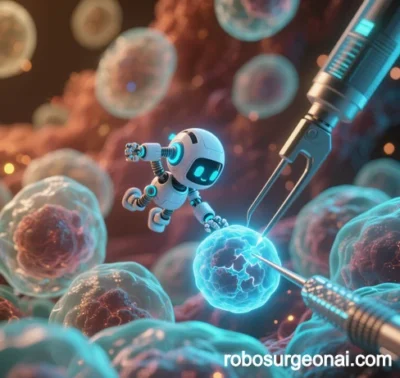
Robosurgeon AI: Advancing Precision, Automation, and Safety in Robotic Surgery
(as of May 2025)
I. Precision Revolution: From Submillimeter Accuracy to Multimodal Sensing
Submillimeter Surgical Precision
- Da Vinci Surgical Robot: AI-powered visual navigation reduces minimally invasive incision errors to below 0.1 mm, enabling cellular-level precision in vascular anastomosis and nerve repair.
- Orthopedic 3D Modeling: AI algorithms reconstruct patient-specific bone models and integrate real-time intraoperative imaging to achieve over 97% accuracy in joint replacement prosthesis alignment, shortening postoperative recovery by 30%.
Multimodal Sensory Integration
- AI-Guided Imaging: Real-time fusion of CT, MRI, and intraoperative fluorescence imaging delineates tumor boundaries and marks critical structures (e.g., brainstem, spinal cord), reducing neurosurgical injury risks by 45%.
- Tactile-Visual Synergy: E-skin with force feedback systems (e.g., Intuitive Surgical’s EndoWrist®) provides 0.1-Newton tactile perception, identifying vascular pulsation differences to prevent microthrombus dislodgement during coronary bypass.
Dynamic Adaptation
- Respiratory Compensation Algorithms: AI predicts respiratory phases and adjusts robotic arm trajectories in real time, limiting liver biopsy targeting errors to 0.3 mm during thoracic-abdominal surgeries.
II. Automation Breakthroughs: From Assistance to Autonomous Decision-Making
Semi-Autonomous Task Execution
- Autonomous Suturing Systems: AI analyzes tissue tension and vascular patterns to optimize suturing steps (e.g., stitch spacing), reducing gastrointestinal anastomosis time from 15 to 3 minutes.
- Intelligent Hemostasis Modules: Spectral analysis identifies bleeding sources (arterial/venous) and auto-adjusts electrocautery power, cutting blood loss by 40% in liver resections.
Closed-Loop Process Control
- Dynamic Path Planning: AI integrates intraoperative OCT imaging to generate obstacle-avoidance paths for deep brain electrode placement, achieving 92% efficacy in postoperative seizure control.
- Adaptive Energy Management: Ultrasonic scalpel power auto-adjusts to tissue impedance, minimizing thermal damage in prostatectomies and restoring urinary control within 7 days.
Cognitive Surgical Systems
- Risk Prediction and Intervention: Machine learning models trained on 300,000 surgical cases predict intraoperative hypotension 15 minutes in advance, autonomously adjusting IV rates to stabilize hemodynamics.
- Multi-Robot Collaboration: Endoscopic robots, robotic arms, and nanoknife systems synchronize via 5G networks to resect tumors and ablate margins simultaneously.
III. Safety Paradigm Shift: From Risk Mitigation to Proactive Defense
Preoperative Risk Stratification
- 3D Anatomic Risk Mapping: AI generates patient-specific vascular models (e.g., hepatic portal variations) to predict bleeding risks and optimize contingency plans, reducing high-risk surgery mortality by 28%.
Intraoperative Real-Time Monitoring
- Tissue Viability Assessment: Raman spectroscopy AI analyzes resection margins in real time, achieving 100% negative margin rates in breast-conserving surgeries.
- Neural Function Preservation: Cortical stimulation paired with AI-driven motor evoked potential analysis lowers spinal injury risks, reducing neurological complications in scoliosis correction to 0.5%.
Postoperative Smart Recovery
- Complication Prediction: AI analyzes EHR and wearable data to predict deep vein thrombosis 72 hours in advance, improving prophylactic anticoagulation efficacy to 89%.
- Personalized Rehabilitation: Robotic kinematic data (e.g., joint mobility, muscle strength) generate customized recovery plans, restoring 95% gait symmetry within 6 weeks post-knee replacement.
IV. Challenges and Future Directions
Interdisciplinary Integration
- Multimodal Data Fusion: Overcoming heterogeneity barriers between medical imaging, biosignals, and robotic motion data to unify semantic frameworks.
- Tactile-Visual-Force Integration: Developing neuromorphic sensors (e.g., memristor-based) for human-like multimodal interaction.
Ethical and Regulatory Balance
- Accountability Frameworks: Establishing legal guidelines for “human-AI shared decision-making” to define autonomy thresholds and physician oversight.
- Data Privacy: Federated learning and homomorphic encryption enable GDPR/HIPAA-compliant distributed surgical databases.
Democratizing Access
- Cost-Effective Modular Design: Open-source platforms (e.g., Raven II) and 3D printing cut system costs from $2 million to $500,000.
- Remote Surgery Networks: 6G and edge computing enable transcontinental telesurgery with 5-millisecond latency.
Conclusion
Robosurgeon AI is redefining surgical excellence: it surpasses human physiological limits in precision, automates complex decision-making, and transforms safety from reactive to proactive. As brain-computer interfaces, quantum computing, and synthetic biology converge, the next decade may witness fully autonomous “scarless surgery”—from incision to closure—with physicians evolving into strategic supervisors and ethical guardians. This evolution demands not only innovation but also a collaborative, cross-cultural ecosystem to ensure equitable global access to these advancements.
Data sourced from publicly available references. For collaborations or domain inquiries, contact: chuanchuan810@gmail.com.





